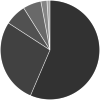Diagnostic utility of the serum-ascites albumin gradient in Mexican patients with ascites related to portal hypertension
- PMID: 33102752
- PMCID: PMC7578298
- DOI: 10.1002/jgh3.12404
Diagnostic utility of the serum-ascites albumin gradient in Mexican patients with ascites related to portal hypertension
Abstract
Background and aim: Analysis of ascitic fluid is necessary to determine the etiology and to distinguish portal hypertension (PH)-related and unrelated ascites. Numerous diagnostic parameters have been studied, but no single parameter has completely distinguished these. We aimed to validate the serum albumin-ascites gradient (SAAG) for the diagnosis of ascites secondary to PH and to establish cutoff points to predict PH using its sensitivity and specificity.
Methods: This was a cross-sectional study conducted on patients diagnosed with ascites of any etiology. The SAAG and albumin concentration in ascitic fluid (AFA) were measured to establish their sensitivity and specificity for determining the presence or absence of PH. Cutoff points and levels of statistical significance were established based on the area under the curve.
Results: Eighty-seven patients were evaluated, of whom 74 (84%) were men, with an average age of 54.0 ± 13.6 years. Seventy-two (83%) were diagnosed at admission with PH-related ascites and 15 (17%) with non-PH-related ascites. SAAG correctly classified 48 (67%) patients, but 24 (33%) were classified incorrectly, while AFA classified 59 (82%) correctly and only 13 (17%) incorrectly. The diagnostic accuracy of SAAG was 57 versus 73% for AFA. AFA had a sensitivity of 82% and specificity of 66% (95% confidence interval [CI]: 0.63-0.93), while SAAG had a sensitivity of 66% but a specificity of 86% (95% CI: 0.72-0.95).
Conclusions: The SAAG showed poor diagnostic performance with low sensitivity but high specificity. The diagnostic accuracy of AFA is superior to that of SAAG in discriminating between PH and non-PH ascites.
Keywords: albumin gradient; ascites; cirrhosis; portal hypertension; serum albumin–ascites gradient.
© 2020 The Authors. JGH Open published by Journal of Gastroenterology and Hepatology Foundation and John Wiley & Sons Australia, Ltd.
Figures

 ), Alcohol; (
), Alcohol; ( ), others (malignancy, peritoneal tuberculosis, spontaneous bacterial peritonitis) (28%); (
), others (malignancy, peritoneal tuberculosis, spontaneous bacterial peritonitis) (28%); ( ), alcohol + hepatotropic virus (7%); (
), alcohol + hepatotropic virus (7%); ( ), hepatotropic virus (6%); (
), hepatotropic virus (6%); ( ), non‐alcoholic steatohepatitis (2%); (
), non‐alcoholic steatohepatitis (2%); ( ), human immunodeficiency virus (1%).
), human immunodeficiency virus (1%).
 ), AFA, albumin concentration in ascitic fluid; (
), AFA, albumin concentration in ascitic fluid; ( ), SAAG, serum–ascites albumin gradient.
), SAAG, serum–ascites albumin gradient.Similar articles
-
The role of ascitic fluid viscosity in the differential diagnosis of ascites.Can J Gastroenterol. 2010 Apr;24(4):255-9. doi: 10.1155/2010/896786. Can J Gastroenterol. 2010. PMID: 20431815 Free PMC article.
-
Role of serum-ascites albumin gradient in differential diagnosis of ascites.J Ayub Med Coll Abbottabad. 2012 Jul-Dec;24(3-4):97-9. J Ayub Med Coll Abbottabad. 2012. PMID: 24669623
-
New proposal for the serum ascites albumin gradient cut-off value in Chinese ascitic patients.Diagn Pathol. 2013 Aug 23;8:143. doi: 10.1186/1746-1596-8-143. Diagn Pathol. 2013. Retraction in: Diagn Pathol. 2015 Mar 26;10:12. doi: 10.1186/s13000-015-0236-x. PMID: 23971938 Free PMC article. Retracted.
-
Does this patient have bacterial peritonitis or portal hypertension? How do I perform a paracentesis and analyze the results?JAMA. 2008 Mar 12;299(10):1166-78. doi: 10.1001/jama.299.10.1166. JAMA. 2008. PMID: 18334692 Review.
-
Ascites in Children.Indian J Pediatr. 2016 Nov;83(11):1334-1340. doi: 10.1007/s12098-016-2168-1. Epub 2016 Jun 9. Indian J Pediatr. 2016. PMID: 27278239 Review.
Cited by
-
Ascites in patients with end-stage renal disease: Challenges and solutions from diagnosis to management.Hepatol Commun. 2025 Apr 3;9(4):e0687. doi: 10.1097/HC9.0000000000000687. eCollection 2025 Apr 1. Hepatol Commun. 2025. PMID: 40178483 Free PMC article. Review.
-
Alcoholic Liver Disease among Patients Admitted to the Department of Internal Medicine of a Tertiary Care Centre: A Descriptive Cross-sectional Study.JNMA J Nepal Med Assoc. 2022 Apr 15;60(248):340-343. doi: 10.31729/jnma.7434. JNMA J Nepal Med Assoc. 2022. PMID: 35633208 Free PMC article.
-
Serum ascites albumin gradient in predicting the severity of hepatic sinusoidal obstruction syndrome induced by pyrrolizidine alkaloids.Clin Exp Hepatol. 2025 Jun;11(2):152-159. doi: 10.5114/ceh.2025.151628. Epub 2025 Jun 26. Clin Exp Hepatol. 2025. PMID: 40904654 Free PMC article.
References
-
- Conway JD, Morgan D. Sleisenger and Fordtran's gastrointestinal and liver disease. pathophysiology/diagnosis/management. Gastroenterology. 2003; 125: 1549–50.
-
- Feldman M, Friedman L, Brandt L. Sleisenger and Fordtran's Gastrointestinal and Liver Disease: Pathophysiology, Diagnosis, Management, Vol. 2 Philadelphia, PA: Elsevier Saunders, 2016.
-
- William SH, Schaffner F, Berk JE. Anatomy and physiology of peritoneum In: Bockus Gastroenterology, 4th edn Philadelphia, PA: W B Saunders Co: 1985; 4177–8.
-
- McHutchison JG. Differential diagnosis of ascites. Semin. Liver Dis. 1997; 17: 191–202. - PubMed
-
- Hoefs JC. Diagnostic paracentesis. A potent clinical tool. Gastroenterology. 1990; 98: 230–6. - PubMed
LinkOut - more resources
Full Text Sources

